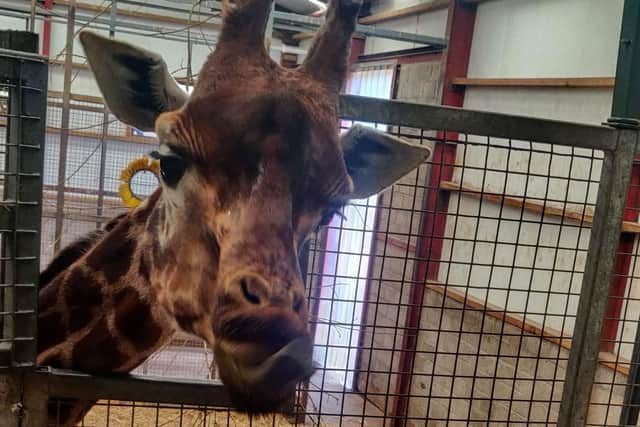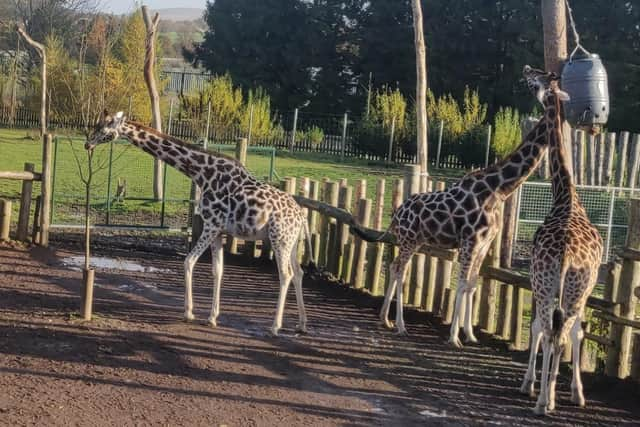How do you entertain a giraffe? Research carried out at Blair Drummond Safari and Adventure Park in Scotland to reveal how
That’s a question that has been bothering zookeepers, academics and conservationists for a long time.
Zoos and wildlife parks play an important role in safeguarding the survival of rare and threatened animals which are struggling to survive in the wild, but the ‘unnatural’ conditions can cause stress and upset for many species.
Advertisement
Hide AdAdvertisement
Hide AdProviding zoo animals with activities and facilities which are sufficiently engaging and entertaining is considered crucial for maintaining their mental and physical health.


But meeting the needs of the world’s tallest animal, used to roaming wide open spaces in the savannahs of Africa, has posed a long-standing challenge.
Now scientists from the University of Glasgow have teamed up with keepers at Blair Drummond Safari and Adventure Park to test out whether the centre’s five female giraffes enjoy a bit of sound therapy.
One of the difficulties in engaging a giraffe’s attention is related to its sleeping patterns. Instead of resting for hours overnight, the animals take frequent brief naps whenever they choose, sleeping for less than 30 minutes at a time.


Giraffes kept in captivity also exhibit a unique behaviour that has left researchers stumped. While awake during the night, they can sometimes be heard humming to themselves, letting out a sustained low-frequency rumble.
Experts are not yet sure why the creatures make these noises, but have speculated that it could be a way of communicating after dark.
The researchers carried out animal-computer interaction experiments that allowed the giraffes to switch on recordings of the humming and of white noise to assess whether or not they would actively choose to listen to audio clips and potentially enjoy the experience.
The findings suggest not.


After an initial period of interest, the Blair Drummond herd seemed to become “bored” with the sound system. So it’s back to the drawing board.
Advertisement
Hide AdAdvertisement
Hide AdThe research, due to be presented at the ACM Interactive Surfaces and Spaces conference on Wednesday, was led by Dr Ilyena Hirskyj-Douglas, from the University of Glasgow’s School of Computing Science.
Dr Hirskyj-Douglas has previously developed interfaces to empower dogs and parrots to use video-calling technology. She has also explored the enrichment potential of helping zoo animals, including saki monkeys, to choose to play audio and visual content on demand.
She said: “Giraffes are increasingly endangered in the wild, so for wildlife-preservation purposes it’s important that we try to make their lives in captivity as rewarding as possible. Previous studies, including my own, have shown that computer systems have real potential to deliver enriching experiences for zoo animals.
“What we set out to do in this first study on interactive systems for giraffes is to try to start to map out how devices might work for them.
“How could we adapt systems to their preferences, and what might they like to hear when they used the prototypes to trigger sounds?
“As it turned out, it seems the sound of other giraffes humming isn’t as appealing as we might have expected, which gives us an important data point to move forward with.
“It could also help unravel the mystery of why giraffes in captivity make this humming sound, which is similar to the vocalisations they make to each other, but could have another purpose which they don’t necessarily enjoy hearing played back to them.”
Alasdair Gillies, research co-ordinator at Blair Drummond, said: “Using interactive systems as a form of enrichment represents an innovative and exciting approach to empowering animals, granting them control and choice over their environment and how they spend their time.
Advertisement
Hide AdAdvertisement
Hide Ad“Conventional enrichment methods often rely on food as the primary motivator, which can be restrictive. We take pride in contributing to the ongoing effort to expand the type of experiences we can offer our animals.”
Comments
Want to join the conversation? Please or to comment on this article.